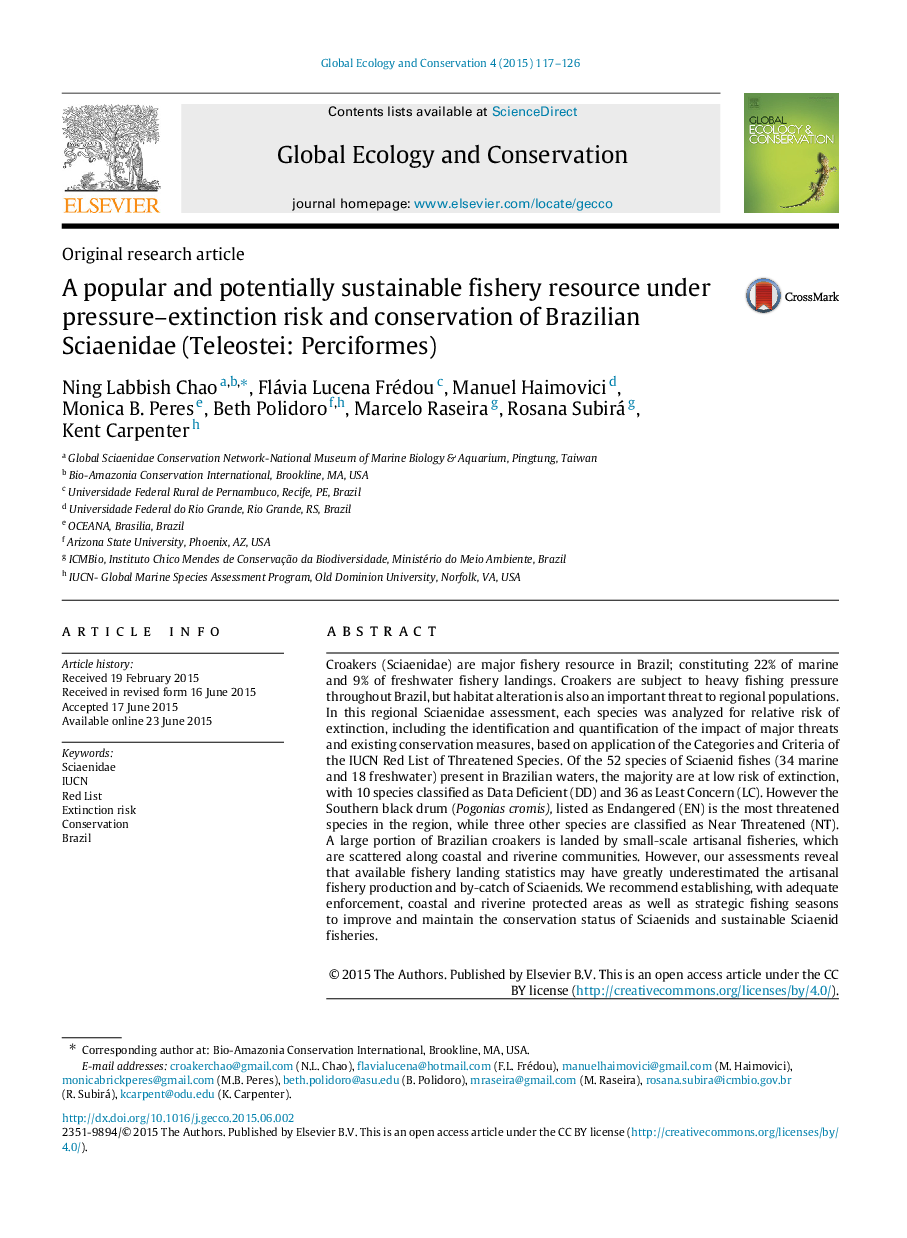| Article ID | Journal | Published Year | Pages | File Type |
|---|---|---|---|---|
| 4379487 | Global Ecology and Conservation | 2015 | 10 Pages |
Croakers (Sciaenidae) are major fishery resource in Brazil; constituting 22% of marine and 9% of freshwater fishery landings. Croakers are subject to heavy fishing pressure throughout Brazil, but habitat alteration is also an important threat to regional populations. In this regional Sciaenidae assessment, each species was analyzed for relative risk of extinction, including the identification and quantification of the impact of major threats and existing conservation measures, based on application of the Categories and Criteria of the IUCN Red List of Threatened Species. Of the 52 species of Sciaenid fishes (34 marine and 18 freshwater) present in Brazilian waters, the majority are at low risk of extinction, with 10 species classified as Data Deficient (DD) and 36 as Least Concern (LC). However the Southern black drum (Pogonias cromis), listed as Endangered (EN) is the most threatened species in the region, while three other species are classified as Near Threatened (NT). A large portion of Brazilian croakers is landed by small-scale artisanal fisheries, which are scattered along coastal and riverine communities. However, our assessments reveal that available fishery landing statistics may have greatly underestimated the artisanal fishery production and by-catch of Sciaenids. We recommend establishing, with adequate enforcement, coastal and riverine protected areas as well as strategic fishing seasons to improve and maintain the conservation status of Sciaenids and sustainable Sciaenid fisheries.
RésuméOs peixes Cienídeos são os recursos mais importantes da pesca extrativa no Brasil. Constituem 22% dos desembarques marinhos e 9% dos continentais e estão sujeitos a forte pressão de pesca, embora a destruição de habitat seja considerada como uma das maiores ameaças. A avaliação regional dos Cianídeos teve como objetivo analisar o risco de extinção, identificar as principais ameaças e medidas de manejo para esse grupo no Brasil. Nós aplicamos os critérios da lista vermelha da IUCN em 52 espécies, sendo 34 marinhas e 18 de água-doce. Cianídeos estão sob baixo a moderado risco de extinção. Uma espécie marinha, a miragaia Pogonias cromis, está regionalmente Em Perigo (EN), enquanto uma espécie marinha e duas de água-doce estão Quase Ameaçadas (NT). Adicionalmente, 10 espécies foram categorizadas como Dados Insuficientes (DD), 36 como Menos Preocupante (LC) e duas espécies marinhas com registros incidentais como Não Aplicável (NA). Uma grande parcela dos Cianídeos no Brasil são capturados pela pesca artesanal, dispersa nas comunidades costeiras e ribeirinhas. As estatísticas de desembarque no Brasil, em geral, subestimam a pesca de pequena escala e a captura incidental dos Cianídeos. Nós recomendamos, com o cumprimento apropriado, o estabelecimento de períodos e areas protegidas nas zonas costeiras e continentais, definidas estrategicamente de forma a manter a conservação deste grupo e a atividade de pesca em níveis sustentáveis.
